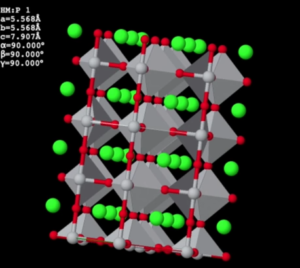Materials cookbook

A page from the Materials Project’s Materials Explorer platform, which allows researchers to design new compounds with the software’s structure editor and substitution algorithms. (Image: Materials Project, Lawrence Berkeley National Laboratory.)
Like gourmet chefs using quality ingredients to prepare a meal, engineers rely on the rich properties of novel materials to solve problems and design new devices. But unlike chefs, researchers haven’t been able to browse a catalog of available materials to combine desirable properties. Instead they’ve often had to design new materials alongside technology or rely on trial and error to find the right compound for an application. Thomas Edison, for instance, spent years seeking a substance that provided the right combination of conductivity, incandescence and stability for his light-bulb filament, and at that he did not identify tungsten.
The Materials Project at the Department of Energy’s Lawrence Berkeley National Laboratory (LBNL) fills that gap. This online tool offers computational data on a range of materials properties for virtually every known inorganic substance. It allows experimenters to search for compounds with the most promising properties and use the datasets to find interesting trends.
Kristin Persson started thinking about the Materials Project more than a decade ago, after completing an industrial project. The alkaline battery maker Duracell had approached Gerbrand Ceder of the Massachusetts Institute of Technology about collaborating on the search for a new cathode material. The researchers wanted to use supercomputers owned by their parent company, Procter & Gamble, to seek potential options, says Persson, a postdoc in Ceder’s group at the time.
Unlike researchers in many other scientific fields, materials scientists aren’t drowning in data, Persson says. Though experimentalists have collected a range of materials’ chemical structures, “there’s a dearth of good quality materials data (from experiments), and it’s not collected in any particular database.” Where such data exist, they are often owned by industry, and public information is scattered across research articles, largely inaccessible to people who would like to use it. That’s where computational materials science had the potential to fill an important gap.
Persson arrived at LBNL in 2008, and she wondered about extending the Duracell project approach into the public domain. One perk of working at a national laboratory is the synergy that can come from casual conversations in the cafeteria, she adds. “You will actually get people saying, ‘Oh, that sounds so cool. I want to help out,’ with no funding whatsoever initially.” By 2010, she had built a small team at Berkeley and with Ceder and others and received a small laboratory-directed research and development grant to get started. In 2012, she received a large DOE grant to support the Materials Project. This openly available online tool includes a variety of materials properties generated by clusters at LBNL’s National Energy Research Scientific Computing Center and other DOE computational user facilities. The interface enables searching the properties of more than 68,000 known inorganic materials.
By that time, the computational materials science field was well positioned to fill this void. In the early 1990s, obtaining computational materials data had also been a relatively slow process. Researchers were still developing code and benchmarking basic calculations against experimental data. A major challenge was developing a library of approximations, known as pseudopotentials, that simplify the chemical behavior of specific elements into values that are easier to quantify. Today libraries of pseudopotentials are available, and algorithms and computing have improved dramatically, Persson says. As a result, researchers can compute multiple physical properties, including nuclear magnetic resonance spectra for materials, almost immediately.
That has two important benefits. First, researchers can get fast feedback as they ask questions about a material. “The thinking process becomes different,” Persson says. “You end up asking more complicated questions than you would if you had to wait a long time.” Second, researchers can now mine these large datasets for trends they might not have seen otherwise, casting a broad net and investigating, say, how a material’s structure might relate to its elastic response or polarizability. Researchers can both test hypotheses and get inspiration from large amounts of data that are relatively cheap to obtain but hadn’t been available.
Persson’s own research group uses the Materials Project to study a range of questions, including water-splitting catalysts, carbon dioxide reduction catalysts, magnesium multivalent batteries and lithium-ion batteries. One challenge in designing water-splitting catalysts is finding molecules that have the right electronic structure and are chemically stable in water.
The Materials Project now has more than 30,000 registered users with as many as 400 logging on each day. The resource includes most of the world’s known materials, starting with all the materials in the Inorganic Crystal Structures Database, which also is regularly updated. In addition, crowdsourcing is coming into play: Other computational materials scientists have started submitting structures of their compounds.
To build on all of its success, the Materials Project must meet challenges in maintaining its web interface and databases. Because the research funding cycle in the United States typically runs three to five years with a limited number of renewals, Persson is concerned about the project’s longevity. (The project’s first round of DOE funding concludes in October 2017, and they’ve sent in a renewal proposal.)
Persson stresses how important it is to continually invest in the people and resources to oversee these types of data projects. “More effort needs to be put into maintenance and development on the software infrastructure because it’s really exploding in so many areas. We are doing pretty well on this, but it does need continuous money and support.”
About the Author
Sarah Webb is science communications manager at the Krell Institute. She’s managing editor of DEIXIS: The DOE CSGF Annual and producer-host of the podcast Science in Parallel. She holds a Ph.D. in chemistry, a bachelor’s degree in German and completed a Fulbright fellowship doing organic chemistry research in Germany.




